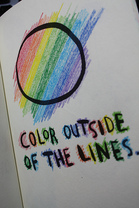
Photo source: flickr - caitysparkles
The final presentation I gave in my MBA program involved me taking off my pants. It was meant to be a literal representation of the shedding of my inhibitions. Lest I were to doubt my own comfort with risk by the end of the program, I decided to stand before the class and take off my pants.
Cheap shock tactic? Perhaps. Liberating? Yes. Pointless? Not quite. My message was clear: know your boundaries and challenge them. To paraphase Seth Godin, forget thinking outside the box; it is at the edges of what we deem possible that creativity is most potent.
Cheap shock tactic? Perhaps. Liberating? Yes. Pointless? Not quite. My message was clear: know your boundaries and challenge them. To paraphase Seth Godin, forget thinking outside the box; it is at the edges of what we deem possible that creativity is most potent.
Too often we are faced with a task or problem that seems too nebulous, too unclear, too vague. We are then told that to solve the problem we need to be creative, to think "outside the box". But how can one think outside the box when one doesn't even realize how big the box is, let alone how it is shaped?
Eric Ries, Lean Startup master, defines a startup as an effort to "deliver a new product or service under conditions of extreme uncertainty". The Lean Startup methodology then teaches that it is the single life-and-death priority of the startup to reduce this uncertainty by learning as much as it can about its customers, environment, challenges, etc. In other words, find your constraints! For every unit of learning, the extreme uncertainty surrounding the startup becomes more defined and illuminated. In essence, the learning points form the outer boundaries of the startup's locus of existence. A box is eventually shaped and created, giving the startup a better-defined area within which to operate. It is only after knowing its constraints that the startup is able to deliver its true value and to then push its boundaries of possibilities.
Two days ago, I had the privilege of listening to the quirky (and Canadian!) Stewart Butterfield, co-founder of flickr, at the PwC Vision to Reality entrepreneurship conference. In it he masterfully described his take on the evolution of technology and our usage of it, reliance on it and our holistic development because of it. He then spoke for a minutes about how most creativity depends on constraints. That, in fact, "constraints are inseparable from creativity". Music, for example, remains beautiful despite being constrained to the rules of scales, notes, keys and other principles of the art.
True mastery of a discipline comes from thoroughly understanding the constraints around it. Once the constraints are mastered, they can be toyed with, pushed or even broken, unlocking a brave new world. Creative tension is greatest between what is and what is not, the possible and the impossible, because the moment that boundary is shifted or breached we are forced to rethink our frontiers. Even Shakespeare's troubled Hamlet displayed this as he pondered the timeless question: "To be or not to be?"
So next time you are stuck on a problem, ask yourself what the constraints are and make the effort to truly understand them. Don't overthink about trying to step outside your boundaries and don't be too content to be within the box. It's on the boundary that your creativity can be unlocked.
Eric Ries, Lean Startup master, defines a startup as an effort to "deliver a new product or service under conditions of extreme uncertainty". The Lean Startup methodology then teaches that it is the single life-and-death priority of the startup to reduce this uncertainty by learning as much as it can about its customers, environment, challenges, etc. In other words, find your constraints! For every unit of learning, the extreme uncertainty surrounding the startup becomes more defined and illuminated. In essence, the learning points form the outer boundaries of the startup's locus of existence. A box is eventually shaped and created, giving the startup a better-defined area within which to operate. It is only after knowing its constraints that the startup is able to deliver its true value and to then push its boundaries of possibilities.
Two days ago, I had the privilege of listening to the quirky (and Canadian!) Stewart Butterfield, co-founder of flickr, at the PwC Vision to Reality entrepreneurship conference. In it he masterfully described his take on the evolution of technology and our usage of it, reliance on it and our holistic development because of it. He then spoke for a minutes about how most creativity depends on constraints. That, in fact, "constraints are inseparable from creativity". Music, for example, remains beautiful despite being constrained to the rules of scales, notes, keys and other principles of the art.
True mastery of a discipline comes from thoroughly understanding the constraints around it. Once the constraints are mastered, they can be toyed with, pushed or even broken, unlocking a brave new world. Creative tension is greatest between what is and what is not, the possible and the impossible, because the moment that boundary is shifted or breached we are forced to rethink our frontiers. Even Shakespeare's troubled Hamlet displayed this as he pondered the timeless question: "To be or not to be?"
So next time you are stuck on a problem, ask yourself what the constraints are and make the effort to truly understand them. Don't overthink about trying to step outside your boundaries and don't be too content to be within the box. It's on the boundary that your creativity can be unlocked.
 RSS Feed
RSS Feed